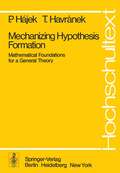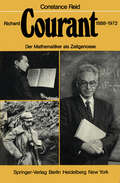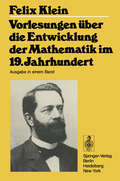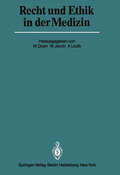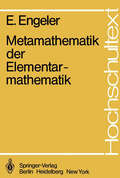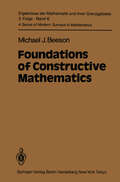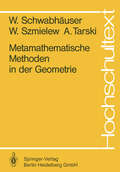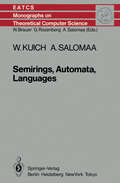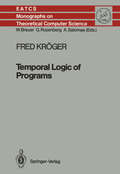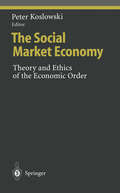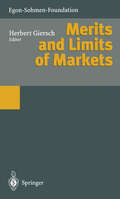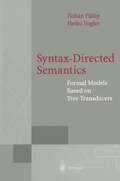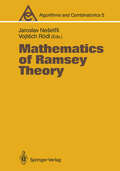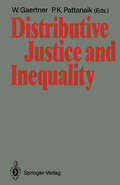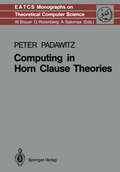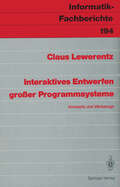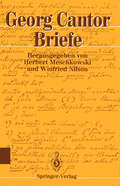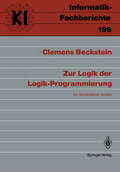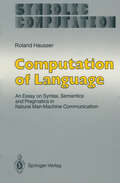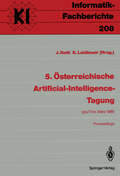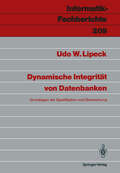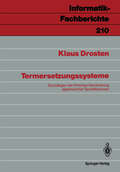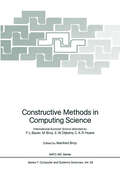- Table View
- List View
Mathematische Logik mit Informatik-Anwendungen (Heidelberger Taschenbücher #187)
by E. Bergmann H. NollMechanizing Hypothesis Formation: Mathematical Foundations for a General Theory (Universitext)
by P. Hajek T. HavranekHypothesis formation is known as one of the branches of Artificial Intelligence, The general question of Artificial IntelligencE' ,"Can computers think?" is specified to the question ,"Can computers formulate and justify hypotheses?" Various attempts have been made to answer the latter question positively. The present book is one such attempt. Our aim is not to formalize and mechanize the whole domain of inductive reasoning. Our ultimate question is: Can computers formulate and justify scientific hypotheses? Can they comprehend empirical data and process them rationally, using the apparatus of modern mathematical logic and statistics to try to produce a rational image of the observed empirical world? Theories of hypothesis formation are sometimes called logics of discovery. Plotkin divides a logic of discovery into a logic of induction: studying the notion of justification of a hypothesis, and a logic of suggestion: studying methods of suggesting reasonable hypotheses. We use this division for the organization of the present book: Chapter I is introductory and explains the subject of our logic of discovery. The rest falls into two parts: Part A - a logic of induction, and Part B - a logic of suggestion.
Vorlesungen über die Entwicklung der Mathematik im 19. Jahrhundert: Teil I (Grundlehren der mathematischen Wissenschaften #24/25)
by Felix KleinFoundations of Constructive Mathematics: Metamathematical Studies (Ergebnisse der Mathematik und ihrer Grenzgebiete. 3. Folge / A Series of Modern Surveys in Mathematics #6)
by M.J. BeesonThis book is about some recent work in a subject usually considered part of "logic" and the" foundations of mathematics", but also having close connec tions with philosophy and computer science. Namely, the creation and study of "formal systems for constructive mathematics". The general organization of the book is described in the" User's Manual" which follows this introduction, and the contents of the book are described in more detail in the introductions to Part One, Part Two, Part Three, and Part Four. This introduction has a different purpose; it is intended to provide the reader with a general view of the subject. This requires, to begin with, an elucidation of both the concepts mentioned in the phrase, "formal systems for constructive mathematics". "Con structive mathematics" refers to mathematics in which, when you prove that l a thing exists (having certain desired properties) you show how to find it. Proof by contradiction is the most common way of proving something exists without showing how to find it - one assumes that nothing exists with the desired properties, and derives a contradiction. It was only in the last two decades of the nineteenth century that mathematicians began to exploit this method of proof in ways that nobody had previously done; that was partly made possible by the creation and development of set theory by Georg Cantor and Richard Dedekind.
Metamathematische Methoden in der Geometrie (Hochschultext)
by W. Schwabhäuser W. Szmielew A. TarskiDas vorliegende Buch besteht aus zwei Teilen. Teil I enthält einen axiomatischen Aufbau der euklidischen Geometrie auf Grund eines Axiomensystems von Tarski, das in einem gewissen Sinne (auch für die absolute Geometrie) gleichwertig ist mit dem Hilbertschen Axiomensystem, aber formalisiert ist in einer Sprache, die für die Betrachtungen in Teil II besonders geeignet ist. Mehrere solche Axio mensysteme wurden schon vor langer Zeit von Tarski veröffentlicht. Hier wird nun die Durchführung eines Aufbaus der Geometrie auf Grund eines solchen Axiomensystems - unter Benutzung von Resultaten von H. N. Gupta - allgemein zugänglich gemacht. Die vorliegende Darstel lung wurde vom zuerst genannten Autor allein geschrieben, aber sie beruht zum Teil auf unveröffentlichten Resultaten von Alfred Tarski und Wanda Szmielew; daher gebührt ihnen ein Teil der Autorschaft. Mehr über Entstehung und Inhalt von Teil I sowie über die Geschichte der Tarskischen Axiomensysteme wird in der Einleitung (Abschnitt I.O) gesagt. Teil II enthält metamathematische Untersuchungen und Ergebnisse über verschiedene Geometrien, was vielfac~ auf eine Anwendung von Methoden und Sätzen der mathematischen Logik auf Geometrien hinausläuft (vgl.
Semirings, Automata, Languages (Monographs in Theoretical Computer Science. An EATCS Series #5)
by W. Kuich A. SalomaaAutomata theory is the oldest among the disciplines constituting the subject matter of this Monograph Series: theoretical computer science. Indeed, automata theory and the closely related theory of formal languages form nowadays such a highly developed and diversified body of knowledge that even an exposition of "reasonably important" results is not possible within one volume. The purpose of this book is to develop the theory of automata and formal languages, starting from ideas based on linear algebra. By what was said above, it should be obvious that we do not intend to be encyclopedic. However, this book contains the basics of regular and context-free languages (including some new results), as well as a rather complete theory of pushdown automata and variations (e. g. counter automata). The wellknown AFL theory is extended to power series ("AFP theory"). Additional new results include, for instance, a grammatical characterization of the cones and the principal cones of context-free languages, as well as new decidability results.
Temporal Logic of Programs (Monographs in Theoretical Computer Science. An EATCS Series #8)
by Fred KrögerZwei Kulturen: Intuition und Logik in Kunst und Wissenschaft
by Evgenij L. FeinbergFeinberg präsentiert in seinem Buch neue Ideen über spezifische Züge und Funktionen von Kunst und Menschlichkeit, Wissenschaft und Technologie sowie ihre Rolle sowohl in der Vergangenheit als auch in der Zukunft. Er gibt eine detaillierte Analyse vieler Beispiele dieser "zwei Kulturen" aus dem täglichen Leben und bei der strategischen Entscheidungsfindung, die es ermöglicht, sich tiefgründige philosphische Konzepte sowohl von der intuitiven als auch von der logischen Seite unseres Wissens vorzustellen.
Merits and Limits of Markets (Publications of the Egon-Sohmen-Foundation)
by Herbert GierschThe 1997 Symposium of the Egon-Sohmen-Foundation, which gave rise to this book, took place in the United States, on the East Coast between New Y C)rk and New Haven, more precisely in Stamford (Conn.). The original choice had been a place close to Yale University, where Egon Sohmen taught economics from 1958 to 1960, subsequent to his period at MIT. But the hotel in New Haven was closed down by a new owner-to pass through a process of creative destruction. Change of ownership-on a large scale and as a transition from public to private hands-had been the topic of the preceding Egon Sohmen-Symposium (in Budapest in 1996) published under the head ing: Privatization at the End of the Century (Springer-Verlag, 1997). Yet mere change of ownership, some of us at the Foundation felt in subsequent months, was too narrow a focus to properly deal with the movement under consideration: a transition of ownership together with a general move towards a competitive market system charac terized by global openness, uncertainty, decentralized risk-bearing, and the increasing importance of information and innovation.
Syntax-Directed Semantics: Formal Models Based on Tree Transducers (Monographs in Theoretical Computer Science. An EATCS Series)
by Zoltan Fülöp Heiko VoglerThis is a motivated presentation of recent results on tree transducers, applied to studying the general properties of formal models and for providing semantics to context-free languages. The authors consider top-down tree transducers, macro tree transducers, attributed tree transducers, and macro attributed tree transducers. A unified terminology is used to define them, and their transformational capacities are compared. This handbook on tree transducers will serve as a base for further research.
Mathematics of Ramsey Theory (Algorithms and Combinatorics #5)
by Jaroslav Nesetril Vojtech RödlOne of the important areas of contemporary combinatorics is Ramsey theory. Ramsey theory is basically the study of structure preserved under partitions. The general philosophy is reflected by its interdisciplinary character. The ideas of Ramsey theory are shared by logicians, set theorists and combinatorists, and have been successfully applied in other branches of mathematics. The whole subject is quickly developing and has some new and unexpected applications in areas as remote as functional analysis and theoretical computer science. This book is a homogeneous collection of research and survey articles by leading specialists. It surveys recent activity in this diverse subject and brings the reader up to the boundary of present knowledge. It covers virtually all main approaches to the subject and suggests various problems for individual research.
Distributive Justice and Inequality: A Selection of Papers Given at a Conference, Berlin, May 1986
by Wulf Gaertner Prasanta K. PattanaikFrom May 20 to May 24, 1986 a conference on distributive justice and in equality was held at the Institute for Advanced Study Berlin (Wis senschaftskolleg zu Berlin). More than thirty scholars participated in this conference. The topics of the presentations ranged from ethics, welfare economics and social choice theory to characterizations of inequality meas ures and redistributive taxation schemes. This book contains a selection of the papers given at the conference. This collection of articles also appeared as issues 2 and 3 of volume 5 of Social Choice and Welfare. In the first paper P. Suppes argues for a pluralistic concept of equity. For too long the emphasis has been on income distribution but there are other characteristics which are important when one talks about equity. Suppes suggests that it would be desirable to have Lorenz curves for a variety of fea tures of societies, such as education, health and housing. P. Dasgupta studies the quality of lives in terms of an index of living stand ards. One has to distinguish between "same number choices" (the number of lives is given) and "different numbers choices" (problem of optimum popUlation). The author argues that in the latter case the anonymity (or sym metry) axiom cannot be readily defended. Once it is dropped, however, an incoherence in the moral ordering of possible worlds arises. The moral basis for different numbers choices becomes generation-dependent, an overall moral ordering of possible worlds no longer exists.
Computing in Horn Clause Theories (Monographs in Theoretical Computer Science. An EATCS Series #16)
by Peter PadawitzAt least four research fields detennine the theoretical background of specification and deduction in computer science: recursion theory, automated theorem proving, abstract data types and tenn rewriting systems. As these areas approach each other more and more, the strong distinctions between functional and relational views, deductive and denotational approaches as well as between specification and programming are relieved in favour of their integration. The book will not expose the lines of this development; conversely, it starts out from the nucleus of Hom clause logic and brings forth both known and unknown results, most of which affect more than one of the fields mentioned above. Chapter 1 touches on historical issues of specification and prototyping and delimits the topics handled in this book from others which are at the core of related work. Chapter 2 provides the fundamental notions and notations needed for the presentation and interpretation of many-sorted Horn clause theories with equality. Chapter 3 supplies a number of sample Hom clause specifications ranging from arithmetic through string manipulation to higher data structures and interpreters of programming languages. Some of these examples serve as a reference to illustrate definitions and results, others may throw a light on the strong link between specifications and programs, which are executed by applying deduction rules. Thus we have included examples of how to use program trans/ormation methods in specification design.
Interaktives Entwerfen großer Programmsysteme: Konzepte und Werkzeuge (Informatik-Fachberichte #194)
by Claus LewerentzIm Rahmen des Forschungsprojektes IPSEN (Incremental Programming Support Environment) wurden Konzepte zum Bau hochgradig interaktiver und integrierter Software-Entwicklungsumgebungen erarbeitet und ihre Brauchbarkeit in einer Prototyp-Implementierung nachgewiesen. Die wesentlichen Charakteristika des IPSEN-Ansatzes sind der hohe Grad an Integration verschiedener Software-Werkzeuge und -Dokumente und der Einsatz eines einheitlichen Modellierungs- und Realisierungsmechanismus für Software-Entwicklungsumgebungen. Software-Dokumente werden intern als attributierte Graphstrukturen modelliert, und Werkzeuge werden als Graphprozessoren über solchen Strukturen aufgefaßt. Die vorliegende Arbeit, die über einen Teil dieses Projektes berichtet, beschäftigt sich in erster Linie mit Konzepten und Werkzeugen für den Arbeitsbereich "Programmieren im Großen", d.h. mit dem Entwerfen von Programmsystemen auf der Ebene von Teilsystemen, Modulen, Modulschnittstellen und -beziehungen. Es wird ein Modulkonzept zusammen mit einer entsprechenden Entwurfssprache vorgestellt und diskutiert, wie damit beschriebene Systemarchitekturen in vorgegebene Programmiersprachen abgebildet werden können. Hinzu kommen Konzepte zur Beschreibung und Verwaltung von Varianten und Revisionen von Systemkomponenten. Die Erstellung technischer Dokumentation und die Verwaltung eines Projektteams werden ebenfalls behandelt. Zu jedem Arbeitsbereich werden Syntax-gesteuerte Editoren, Analyse- und Transformationswerkzeuge vorgestellt, die integriert zusammenarbeiten und sich dem Benutzer auf einheitliche Weise präsentieren. Die Realisierung dieser Werkzeuge gemäß dem "Graphentechnik"-Ansatz wird kurz dargestellt, im Anhang der Arbeit findet sich eine formale Beschreibung des verwendeten Graphgrammatik-Kalküls.
Briefe
by Georg CantorDas Buch enthält 185 vollständige chronologisch geordnete Briefe Cantors aus den verschiedenen Perioden seines Lebens, von denen ein großer Teil erstmals veröffentlicht wird. Aus ihnen wird die Entwicklung des Cantorschen Werkes ebenso deutlich wie die Stellung zu seinen Kollegen und das Ringen um die Anerkennung seiner Theorie. Durch die Vollständigkeit der Briefe und die damit verbundene Einbeziehung auch privater Passagen gewinnt man darüber hinaus Einblicke in Bereiche dieses Forscherlebens, ohne die man die vielschichtige Persönlichkeit Cantors kaum annähernd erfassen kann. Man erkennt, daß manches an dem bisherigen "Cantorbild" revisionsbedürftig ist oder zumindest differenzierter gesehen werden muß. Die den Briefen beigegebenen ergänzenden und erläuternden Kommentare enthalten häufig Passagen aus Antwortschreiben oder weiteren Briefen Cantors, die für das Verständnis der behandelten Sachverhalte hilfreich sind oder sogar neue Aspekte erkennen lassen. Ferner weisen sie auf Zusammenhänge zwischen den Briefen hin. Eine so ausgiebige Kommentierung ist bei wissenschaftlichen Briefsammlungen nicht sehr verbreitet. Ebenfalls hervorzuheben ist das sorgfältig zusammengestellte Sachverzeichnis, das zugleich Hinweise auf die in den Briefen behandelten Themen gibt. Man gewinnt mit diesem Werk eine "Autobiographie" Cantors, die zusammen mit den von Zermelo herausgegebenen "Gesammelten Abhandlungen" (auf die häufig verwiesen wird) ein umfassendes Bild von Leben und Werk dieses großen Forschers liefert.
Zur Logik der Logik-Programmierung: Ein konstruktiver Ansatz (Informatik-Fachberichte #199)
by Clemens BecksteinComputation of Language: An Essay on Syntax, Semantics and Pragmatics in Natural Man-Machine Communication (Symbolic Computation)
by Roland HausserThe study of linguistics has been forever changed by the advent of the computer. Not only does the machine permit the processing of enormous quantities of text thereby securing a better empirical foundation for conclusions-but also, since it is a modelling device, the machine allows the implementation of theories of grammar and other kinds of language processing. Models can have very unexpected properties both good and bad-and it is only through extensive tests that the value of a model can be properly assessed. The computer revolution has been going on for many years, and its importance for linguistics was recognized early on, but the more recent spread of personal workstations has made it a reality that can no longer be ignored by anyone in the subject. The present essay, in particular, could never have been written without the aid of the computer. I know personally from conversations and consultations with the author over many months how the book has changed. If he did not have at his command a powerful typesetting program, he would not have been able to see how his writing looked and exactly how it had to be revised and amplified. Even more significant for the evolution of the linguistic theory is the easy testing of examples made possible by the implementation of the parser and the computer-held lexicon. Indeed, the rule set and lexicon grew substantially after the successes of the early implementations created the desire to incorporate more linguistic phenomena.
5. Österreichische Artificial-Intelligence-Tagung: Igls/Tirol, 28.-31. März 1989 Proceedings (Informatik-Fachberichte #208)
by Johannes Retti Karl LeidlmairDynamische Integrität von Datenbanken: Grundlagen der Spezifikation und Überwachung (Informatik-Fachberichte #209)
by Udo W. LipeckAufgabe des Datenbank-Entwurfs ist es, nicht nur die statische Struktur, sondern auch das dynamische Verhalten eines Datenbanksystems zu spezifizieren. Um festzulegen, welche Folgen von Datenbankzuständen zulässig sind, gibt man dynamische Integritätsbedingungen an. Komplementär dazu bestimmen Transaktionen als Grundbausteine von Anwendungsprogrammen die ausführbaren Zustandsfolgen. Diese Monographie stellt zwei Ansätze zur Überwachung der dynamischen Integrität von Datenbanken vor. Es werden theoretische und algorithmische Grundlagen sowie die beim Datenbank-Entwurf erforderlichen Vorbereitungen behandelt. Die Verfahren werden anhand eines durchlaufenden Standardbeispiels demonstriert. Spezifiziert werden Integritätsbedingungen durch Formeln einer temporalen Logik und Transaktionen durch Vor-/Nachbedingungen; die Semantik dieser Kalküle wird im Buch eingeführt. Aus temporalen Formeln lassen sich Transitionsgraphen konstruieren, deren Pfade den zulässigen Zustandsfolgen entsprechen. Daher dienen die Graphen einerseits als Ablaufsteuerung eines universellen Monitors, der die Analyse von Zustandsfolgen auf zustandslokale Prüfungen zurückführt. Andererseits kann man anhand der Graphen Integritätsbedingungen systematisch in Vor-/Nachbedingungen von Transaktionen transformieren, so daß jede ausführbare Zustandsfolge zulässig wird. Das letztere Vorgehen bereitet eine effiziente transaktionsangepaßte Überwachung vor und führt zu einer Spezifikation von Datenbankverhalten durch schrittweise Verfeinerung.
Termersetzungssysteme: Grundlagen der Prototyp-Generierung algebraischer Spezifikationen (Informatik-Fachberichte #210)
by Klaus DrostenTermersetzungssysteme sind ein nicht-deterministisches Berechnungsmodell aus dem Bereich der funktionalen Programmierung. Die Funktionen werden durch rekursive Regeln spezifiziert und durch Untertermersetzung ohne explizite Kontrolle ausgewertet. Die logische Programmierung geht auf den Anfang der 70er Jahre zurück und wurde besonders populär in Verbindung mit der Programmiersprache PROLOG. Die algebraische Programmierung entstand in ihren Grundzügen Mitte der 70er Jahre, als die ersten Arbeiten über die Spezifikation abstrakter Datentypen veröffentlicht wurden. Obwohl die algebraische und die logische Programmierung auf gemeinsamen Prinzipien beruhen, entwickelten sie sich zunächst unabhängig voneinander. Erst in jüngster Zeit wurde mit Erfolg versucht, beide Ansätze in einem gemeinsamen Kalkül zu vereinen. Das Buch wendet sich an alle, die an den theoretischen Grundlagen der algebraischen und logischen Programmierung interessiert sind. Es gibt zunächst einen Überblick über die Grundlagen der Ausführung algebraischer Spezifikationen sowie eine Zusammenfassung der benötigten Grundbegriffe. Das Grundkonzept der algebraischen Spezifikation wird um Ausdrucksmittel zur Fehlerbehandlung und Modularisierung in abstrakten Datentypen erweitert. Die Ausdrucksmittel werden besonders im Hinblick auf ihre Operationalisierbarkeit untersucht. Außerdem wird gezeigt, wie (und wann) sich algebraische Spezifikationen automatisch in PROLOG-Programme übersetzen und mit deren Hilfe ausführen lassen. Zum besseren Verständnis des Textes sind Grundkenntnisse der mathematischen Logik hilfreich.
Constructive Methods in Computing Science: International Summer School directed by F.L. Bauer, M. Broy, E.W. Dijkstra, C.A.R. Hoare (NATO ASI Subseries F: #55)
by F. L. Bauer M. Broy E. W. Dijkstra C. A. HoareComputing Science is a science of constructive methods. The solution of a problem has to be described formally by constructive techniques, if it is to be evaluated on a computer. The Marktoberdorf Advanced Study Institute 1988 presented a comprehensive survey of the recent research in constructive methods in Computing Science. Some approaches to a methodological framework and to supporting tools for specification, development and verification of software systems were discussed in detail. Other lectures dealt with the relevance of the foundations of logic for questions of program construction and with new programming paradigms and formalisms which have proven to be useful for a constructive approach to software development. The construction, specification, design and verification especially of distributed and communicating systems was discussed in a number of complementary lectures. Examples for those approaches were given on several levels such as semaphores, nondeterministic state transition systems with fairness assumptions, decomposition of specifications for concurrent systems in liveness and safety properties and functional specifications of distributed systems. Construction methods in programming that were presented range from type theory, the theory of evidence, theorem provers for proving properties of functional programs to category theory as an abstract and general concept for the description of programming paradigms.

